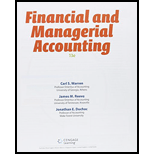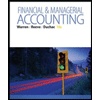
Issuing stock
Epstein Engineering Inc. began operations on January 5. 2016, with the issuance of 500,000 shares of $80 par common stock. The sole stockholders of Epstein Engineering Inc. are Barb Abrams and Dr. Amber Epstein, who organized Epstein Engineering Inc. with the objective of developing a new flu vaccine. Dr. Epstein claims that the flu vaccine, which is nearing the final development stage, will protect individuals against 90% of the flu types that have been medically identified. To complete the project, Epstein Engineering Inc. needs $25,000,000 of additional funds. The local banks have been unwilling to loan the funds because of the lack of sufficient collateral and the riskiness of the business.
The following is a conversation between Barb Abrams, the chief executive officer of Epstein Engineering Inc., and Amber Epstein, the leading researcher:
Barb: What are we going to do? The banks won't loan us any more money, and we've got to have $25 million to complete the project. We are so dose! It would be a disaster to quit now. The only thing I can think of is to issue additional stock Do you have any suggestions?
Amber: I guess you’re right. But if the banks won’t loan us any more money, how do you think we can find any investors to buy stock?
Barb: I’ve been thinking about that What if we promise the investors that we will pay them 5% of sales until they have received an amount equal to what they paid for the stock?
Amber: What happens when we pay back the $25 million? Do the investors get to keep the stock? If they do, it’ll dilute our ownership.
Barb: How about, if after we pay back the $25 million, we make them turn in their stock for $120 per share? That’s one and one-half times what they paid for it, plus they would have already gotten all their money back. That's a $120 profit per share for the investors.
Amber: It could work. We get our money, but don't have to pay any interest, dividends, or the $80 per share until we start generating sales. At the same time, the investors could get their money back plus $120 per share profit
Barb: We’ll need current financial statements for the new investors. I’ll get our accountant working on them and contact our attorney to draw up a legally binding contract for the new investors. Yes, this could work.
In late 2016, the attorney and the various regulatory authorities approved the new stock offering, and 312,500 shares of common stock were privately sold to new investors at the stock’s par of $80.
In preparing financial statements for 2016, Barb Abrams and Dan Fisher, the controller for Epstein Engineering Inc., have the following conversation:
Dan: Barb, I've got a problem.
Barb: What’s that Dan?
Dan: Issuing common stock to raise that additional $25 million was a great idea. But ...
Barb: But what?
Dan: I’ve got to prepare the 2016 annual financial statements, and I am not sure how to classify the common stock.
Barb: What do you mean? It’s common stock.
Dan: I’m not so sure. I called the auditor and explained how we are contractually obligated to pay the new stock-holders 5% of sales until $80 per share is paid. Then, we may be obligated to pay them $120 per share.
Barb: So…
Dan: So the auditor thinks that we should classify the additional issuance of $25 million as debt not stock And. if we put the $25 million on the
- 1. Discuss the arguments for and against classifying the issuance of the $25 million of stock as debt.
- 2. What do you think might be a practical solution to this classification problem?
Want to see the full answer?
Check out a sample textbook solution
Chapter 11 Solutions
Bundle: Financial & Managerial Accounting, Loose-Leaf Version, 13th + CengageNOWv2, 2 terms Printed Access Card
- The Blue Jay Corporation has annual sales of $5,200, total debt of $1,500, total equity of $2,800, and a profit margin of 8 percent. What is the return on assets? Accounting 12arrow_forwardRegal Properties (RP) just acquired land and a building for a single sum of $500,000. An independent appraisal determined the fair values of the assets (if purchased separately) at $350,000 for the land and $250,000 for the building. Prepare the journal entry in table format to record the purchase of the land and building. Need answerarrow_forwardProvide Right answerarrow_forward
- general accountingarrow_forwardexpert of account answerarrow_forwardRJ Industries purchased a tract of land for use as a factory site. The purchase price was $850000. RJ also incurred the following costs: Cost to raze an old warehouse ($75000), legal fees related to the purchase contract ($12000), and proceeds from the sale of salvaged materials ($9000). What amount should be reported as the cost of the land? Helparrow_forward
- Baltimore Manufacturing completes job #725, which has a standard of 720 labor hours at a standard rate of $20.50 per hour. The job was completed in 600 hours, and the average actual labor rate was $21.80 per hour. What is the labor efficiency (quantity) variance? (A negative number indicates a favorable variance and a positive number indicates an unfavorable variance.)arrow_forwardhello teacher please solve questionsarrow_forwardLarkspur Manufacturing Company observed that, during its busiest month of 2022, maintenance costs totaled $18,500, resulting from the production of 40,000 units. During its slowest month, $13,000 in maintenance costs were incurred, resulting from the production of 25,000 units. Use the high-low method to estimate the maintenance cost that the company will incur if it produces 30,000 units. (Calculation in 2 decimal)arrow_forward
 Financial AccountingAccountingISBN:9781305088436Author:Carl Warren, Jim Reeve, Jonathan DuchacPublisher:Cengage Learning
Financial AccountingAccountingISBN:9781305088436Author:Carl Warren, Jim Reeve, Jonathan DuchacPublisher:Cengage Learning Financial AccountingAccountingISBN:9781337272124Author:Carl Warren, James M. Reeve, Jonathan DuchacPublisher:Cengage Learning
Financial AccountingAccountingISBN:9781337272124Author:Carl Warren, James M. Reeve, Jonathan DuchacPublisher:Cengage Learning Survey of Accounting (Accounting I)AccountingISBN:9781305961883Author:Carl WarrenPublisher:Cengage Learning
Survey of Accounting (Accounting I)AccountingISBN:9781305961883Author:Carl WarrenPublisher:Cengage Learning Financial & Managerial AccountingAccountingISBN:9781285866307Author:Carl Warren, James M. Reeve, Jonathan DuchacPublisher:Cengage Learning
Financial & Managerial AccountingAccountingISBN:9781285866307Author:Carl Warren, James M. Reeve, Jonathan DuchacPublisher:Cengage Learning




